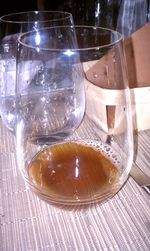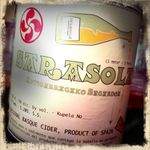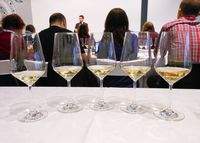Here's a sampling of what our editors and contributors have been drinking…
Evan Dawson: Chateau Frank 2006 Blanc de Blancs and Lenz 2005 Cuvee
Two New York sparklers were chosen as part of a sparkling wine masterclass in Brescia, Italy earlier this month during the European Wine Bloggers Conference. The organizers chose two wines apiece from Champagne, Cava, England, Franciacorta and New York State.
The New York sparkling wines showed very nicely in what was an impressive flight of wines. The overflowing room, sold out at 40 people and consisting mostly of European writers, buzzed about the strengths and personalities of each pair of wines. New York was not an exception.
Dr. Frank's 2006 Blanc de Blancs played both edges of the genre, with plenty of cut to accompany a touch of richness. The Lenz 2005 Cuvee was super-fresh, begging for seafood. I heard more than one writer in the audience remark about how nice it would be to have a plate of shellfish with this wine.
High-quality sparkling wine does not simply come from a cool climate and grapes with high acidity. Special soils and the right balance, derived from a convergence of brix and acidity at harvest, are key. Cheers to the these ambassadors from New York.
 Mark Grimaldi: Mario Marengo 2010 Dolcetto d'Alba
Mark Grimaldi: Mario Marengo 2010 Dolcetto d'Alba
Every year, I await the release of Marengo's Dolcetto. It's one of my favorites. Only 50 cases come into the tri-state area, so it's pretty scarce, but it's a wine that is as quintessential to fall for my me and my wife as picking a pumpkin or eating a local apple is.
Marengo is a tiny domaine, like under 1000 cases tiny, and that includes his regular Barolo, two Cru Barolos ("Brunate" and "Bricco le Viole"), a little Nebbiolo d'Alba, and a smattering of Barbera, and this Dolcetto. One reason Marengo is my favorite, is because he hails from La Morra, and it's a commune in Barolo I hold dear. La Morra's wines are different from the other communes. The soils are sandier, which always give the wines this sort of pretty, feminine, floral aromatics, while still harnessing the power that comes from the Barolo region that everyone knows and loves.
This Dolcetto is deep in color, and thins at the rim to an electric pink garnet color. It smells like a blueberry pie, with a touch of indian spice. On the palate it's simple, with a pure blast of fruit, with good acid that creeps around your tongue up to the roof of your mouth, followed by a bit of grip from the tannins to bring things to a close. The finish is just kind of fades away saying "Whatever, man, im not trying to pretend to be something I'm not". And it isn't. After all, Dolcetto is a simple, unpretentious wine, something that just belongs on your table with family, friends, and a big bowl of pasta. And for $15 retail, this will always have a place on ours.
 Lenn Thompson: Strong Ryeland ESB, a Greenport Harbor Brewing and Southampton Ales Collaboration
Lenn Thompson: Strong Ryeland ESB, a Greenport Harbor Brewing and Southampton Ales Collaboration
Monday night's sold-out NYCR Artisan dinner, showcasing five beers from Greenport Harbor Brewing, was our fourth such dinner, and perhaps the most fun for me because I really enjoy talking about beer with people in the wine industry, especially people who I taste wine with regularly.
When we taste wine together, we inevitably spend a lot of time analyzing it, looking of faults, pointing out intricacies and discussion tannin structure, potential longevity and the like.
Sitting down to drink locally made beers with the same group is more about enjoying ourselves. Sure, we geek out plenty, asking the brewer questions about alcohol levels, inspirations and where he gets his hops, but we don't over-analyze to the point of becoming academia. I like that on occasion.
Of the five beers we tried Friday night — a couple for the first time for me — my favorite was the Strong Ryeland, a collaboration between Greenport Harbor and Southampton. It's a riff on a traditional English ESB that features a serious dose of rye malt.
I love the ESB style as a session beer — far too few American craft brewers make this style — and at 5.5% abv, this one qualifies. It was served from a pin, a small cask, with two types of dry hopping. Lightly malty, caramelly and grainy there is a subtle hoppy character here that comes through grassy and a bit citrusy. Finishing dry with a distinct nuttiness, I can see myself sitting at a bar and drinking several of these in a session.
 David Flaherty: Sarasola Sagardoa Basque Cider
David Flaherty: Sarasola Sagardoa Basque Cider
With Cider Week now rolling back to its bucolic hills and orchards, I realize I've drank a lot of the hard apple stuff lately. While I'm a sucker for all things local and was super stoked to meet the great artisans plying their trades in the Finger Lakes and Hudson Valley, I'm finding a certain fascination with the ciders from the Basque country of Spain. Admittedly, I'm an acidhound. Be it top-notch Rieslings or cocktails made with shrubs (adding a vinegary zip), I'm drawn to the beverages that twist my mouth up in a knot and hold it captive for a few moments. A rolling coaster ride of sensation. Sure, give me balanced flavor and clear fruit, but if you can grab me by the lapels, pull me in close and stare me down with a fervor, you've got my attention.
Clocking in at 6% abv, the Sarasola Sagardoa is one such beast of acidity. Produced in the "natural" style (simply meaning non-sparkling and completely still), this Basque cidra hails from the apple growing hills of Astigarraga near San Sebastian. It's unfiltered and unpasteurized and, if you were having it in the Basque country, would be served directly from the barrel. Aromas of peach, oranges and yeast with a tart apple flavor and generous minerality. And when I say "tart," I mean it. This is akin to sneaking the freshly squeezed lemon juice from your grandmother's fridge before she adds the sugar for your lemonade. Yowza. Your mouth better be ready. I suggest having some food nearby; with the amount of mouth-watering going on, you'll be reaching for it.

